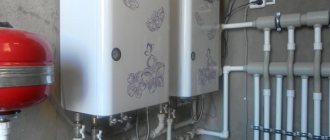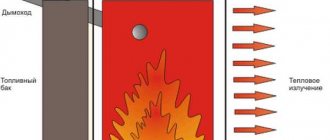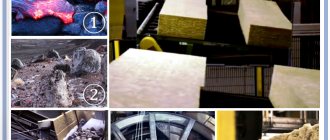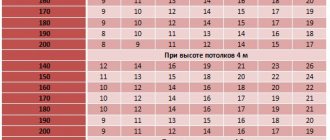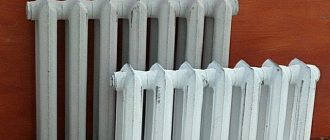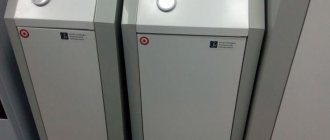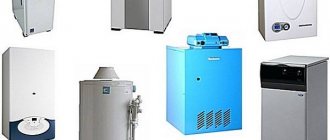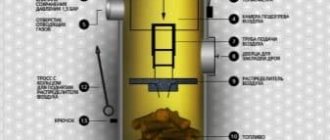Principle of operation
The main components of a fan heater are a heating element and a fan. The first is a metal alloy in the form of a spiral, ceramic plates or heating elements.
Some fan heater models contain several heating elements of the same type.
The main percentage of heat fans are powered via the electrical network.
When a device is connected to it and the operating mode is turned on, the heating element begins to gain temperature, generate heat and heat the air nearby, and the fan pushes the already heated air out.
The warm air is gradually distributed throughout the room.
Types of fan heaters
Classification by heating element type:
- A spiral made of a metal alloy, most often nichrome. Fans with such a heating element are the cheapest.
- Ceramic plates. Considered the safest.
- TEN (tubular electric heater) - the heating element is built inside a metal pipe. A substance with high thermal conductivity is also inserted there.
A metal spiral heats up more than a ceramic plate, so a device with such a heating element heats up the room more. But at the same time, combustion products (dust particles) are released into the air.
Ceramic plates do not have this effect, so they are considered the most harmless. TEN heaters are used for heating spacious rooms, as their performance is very high.
Power classification
A common power value is 1000-2000 watts. Such fan heaters are designed to heat rooms up to 10 square meters. The maximum power threshold for a heat fan is 2000 Watts; higher power is only available for heat guns.
Step adjustment is designed for economical use of the fan heater. The models have a different number of operating modes built into them:
- The first mode is half power (indicated by the number 1 or one dot).
- The second mode is full power (number 2 or two dots).
- The third is the ventilation mode (the heating fan works like a regular fan, without using a heating element).
The most advanced fan heaters have a number of modes that make the device work better:
- The motion sensor helps the device determine the specific location of people in the room and warm up this particular area.
- Uniform heating is ensured by automatic rotation of the fan from side to side.
- Some fan heaters not only have a heating function, but also humidify the air.
The appearance of the fan-heater can be almost anything, it all depends on the designer’s imagination. Today, factories produce products of different shapes and sizes.
The body color is often chosen to be soft (black, white or gray), but sometimes models of other colors are also found.
The fan heater can be controlled mechanically (by rotating switches and pressing buttons) or electronically, when the parameters are displayed on the display.
Another type of heat fan is a heat gun. Its main function is to quickly heat rooms with an area of 10 square meters and above.
If a room heater heats a room of 10 square meters. m in 20-30 minutes, then a heat gun will cope with heating the same room in 10-15 minutes.
Additional functions
The safety of thermal equipment is ensured not only by proper operation, but also by some built-in functions and elements:
- The regulator helps to switch between heating elements of higher or lower power if there are several of them in the heating device.
- Expensive models of thermal equipment have timer or delayed start functions.
- The splash-proof feature is useful if you plan to use the fan in the kitchen or bathroom.
- The thermostat function cools the appliance when it gets too hot.
- A special relay will automatically turn off the fan heater if it falls.
The casing of heat fans is usually made of plastic, so running in a horizontal position can result in a melted casing at best, or a fire at worst.
Assembly features of some types of fan heaters
There are several types of fan heaters, each of them, quite naturally, has its own characteristic pros and cons. Before you start assembling the fan yourself, you should familiarize yourself with some of the features of the device.
Fan heater
Assembling a simple heat fan with your own hands is not difficult for a home craftsman. Some of the necessary parts can be found in stocks of old equipment stored in a closet or garage. You can assemble a heater with your own hands using an old computer system unit. For this you will need:
- Textolite sheet measuring 20x30 cm.
- A couple of meters of nichrome wire with a diameter of 0.2-0.3 mm.
- System unit (parts, except the cooler, are removed from the unit).
- Power supply 12V.
- Thermal fuse for the heater is designed to turn off at temperatures above 70°C.
- Cable, regulators, switches, fasteners, electrical tape or heat shrink tubing.
The design of the heater is very simple and assembling it yourself is not difficult.
- Parts are cut out of fiberglass to make a frame with slots for installing a shadow (nichrome spiral).
- The nichrome thread is twisted into a spiral (for these purposes, use a drill or screwdriver operating at slow speeds, with a fixed rod with a diameter of 2-3 mm).
- The spiral is installed in the frame and secured, power is connected to the points where the ends of the spiral are attached, and a thermal fuse is mounted into the gap in the power wire.
- The frame with the spiral is installed in the system unit.
- The 12V power supply is connected to the cooler.
- The housing is closed, installed on a stand made of dielectric material, and the operation of the heater is checked.
An economical option is a water fan heater. In this case, the heating element is a heat exchanger made independently from a copper pipe or a used car radiator. The coolant to the heat exchanger comes from central heating or individual heating pipes, and electricity is consumed only to ensure the operation of the fan. It is recommended to install such a fan heater in the heating system on the return pipe. When installed on the supply side, a running fan greatly cools the pipe and the coolant enters the heating radiators below the required temperature.
Heat gun
Making a heat gun with your own hands is quite simple. A heater of this type is used for quickly heating and drying walls, floors, damp cellars and during certain types of construction work. To make a mini gun, you can use some parts of unusable household appliances, and buy the missing ones.
You will need the following list of materials:
- Motor and impeller (suitable for a broken vacuum cleaner or kitchen hood).
- A spiral from an unnecessary electric stove is used as a heating element.
- A pipe with a diameter of 150 mm and a wall thickness of 3-5 mm can be made independently from sheet metal.
- Thermal relay that opens the circuit when overheating, switch,
- Asbestos sheet.
- Metal grate.
- Cable and fastening materials (rivets or bolts with nuts).
Assembly is carried out in several stages:
- The electric motor and fan are attached at the end of the pipe.
- Strips are cut out of asbestos and a grid is assembled onto which a heating coil is attached (ceramic insulators can be used for these purposes).
- The resulting heating element is attached to the end of the pipe opposite to the fan.
- The motor and coil are connected to the switch. The scheme provides for a separate connection.
- Metal protective grilles are installed at both ends of the pipe.
- A mobile or stationary stand is made from available materials that are resistant to temperature influences.
WATCH THE VIDEO
If desired, a layer of thermal insulation is attached to the pipe. On the one hand, this increases the level of safety during work, on the other hand, it reduces the heat transfer of the device.
Electric fireplace
A homemade fan heater is used as a heat source for an electric fireplace. It’s easy to make a portal for a fireplace with your own hands from plasterboard. To do this, install a frame from a metal profile of the required configuration and cover it with sheets of plasterboard, after which the outer surface is decorated using facing materials. A structure is installed inside the portal that simulates the burning of wood or coal (finished products are equipped with lighting)
It is important to provide a hole in the structure in advance for laying the cable
Equipment and accessories
The complete set of fan heaters varies according to the type of installation:
- Floor fan heaters are manufactured static or mobile. The former are equipped with durable legs, the latter – with legs or wheels.
- Wall-mounted units are most often installed in small spaces. They are only stationary and are attached to the wall; they often come with a remote control.
Wall or ceiling heat fans are fixed to the surface of the wall or ceiling using a special bracket or mounting bracket.
Some accessories for heating fans:
- A device for adjusting the fan speed helps to avoid overloads and breakdowns.
- To increase the distance covered by a stream of warm air, a special confuser is sold in stores.
- Controllers, on which commands are set and functions are switched, are built into the device during assembly or sold separately.
- For large models, special trolleys are sold, which makes the stationary floor heater mobile.
- Thermostats and controllers are sold separately.
- The mounting console rotates the device body in any direction.
Typically, heating equipment is powered electrically. However, water-powered air ventilation devices are produced. Hot water gives off heat to the heating apparatus, and due to this it works.
TOP 5 fan heaters
Making a choice among all the variety is not easy. I hope this ranking of popular models will help you.
Ballu BFH/S-04 is the simplest unit for 750 rubles. A spiral is used here as a heater, and the fan has an axial structure. Increased power - 2000 W - allows it to be used in rooms up to 25 square meters. m. There is another mode - at 1000 W. Equipped with a thermostat to control overheating.
Pros:
- inexpensive;
- compact;
- coverage of a large area;
- warranty – 2 years.
Minuses:
- only two modes;
- short cord.
Electrolux EFH/C-5115 – desktop copy for 2,200 rubles. Characterized by a power of 1500 W. The special configuration ensures rapid heat distribution. The equipment is equipped with a modern ceramic element. The choice between three possible settings is carried out by two rotary switches. This is a unit with a thermostat and an overheating sensor that turns off the device if necessary.
Pros:
- copes with space up to 20 square meters. m;
- modern design;
- environmentally friendly and high-quality materials;
- the body does not heat up.
Minuses:
- quite noisy;
- wire is only 1 m long;
- low sensitivity thermostat.
Tefal Intense Comfort Hot SE9420F0 is a floor-standing device in the form of a column for 11,000 rubles. The power of the ceramic heater is 2,400 W. It has a wide airflow angle of 90 degrees. Three modes are built-in, including ventilation without heating, and shutdown when tipping over and overheating. There is a thermostat, timer and delayed start, which allows you to program up to 24 hours of operation. I would especially like to note the ECO function, thanks to which electricity consumption is reduced by 50%.
Pros:
- quiet;
- economical;
- long cord;
- there is a remote control.
Minuses:
- the sound of pressing buttons is disturbing at night;
- Fingerprints are visible on the side panels.
Stiebel Eltron CK 20 Trend LCD is an elegant wall-mounted sample costing 14,500 rubles. The rectangular shape and white plastic with gray inserts create a laconic design that will fit into any interior. Power – 2,000 W. A wide range is available from +5 to +30 degrees. It has overheat shutdown functions, a weekly timer, and anti-freeze. Settings are carried out using sensors and a display.
Pros:
- compact and lightweight;
- low noise level;
- There is a compartment for the cord.
Minuses:
- periodic cleaning of the air filter is required;
- no remote control.
Teplomash KEV-25T3W2 - industrial water heater for 18,500 rubles. Its power at a coolant temperature of 80 degrees is 8.3 kW, and at 90 degrees – 11.9 kW. He pushes warm air to a distance of 8 m from himself. The included swivel bracket allows you to install the device on a wall or ceiling.
The set includes two control panels: a wired one (you will have to mount it next to the device) and a remote one. The body is made of galvanized steel coated with powder enamel.
Pros:
- all necessary fasteners included;
- energy efficiency;
- IP44 protection class against dirt and moisture;
- adjustable slats.
Minuses:
- loud;
- installation difficulties.
Pros of a fan heater
- Quickly warms up a spacious room. The heating speed increases depending on the power of the device. Speed leaders are heat guns.
- Safe when used correctly. Modern appliances are equipped with the necessary devices that will prevent the fan heater from melting or catching fire.
Equipment with a ceramic heating element is considered the most fireproof and environmentally friendly.
- A large selection of designs will allow you to choose a fan heater that would suit the interior of the room.
- Mobile models are transported from room to room.
Operating principle of a household electric fan heater
An electric fan heater consists of four main parts:
- frame;
- electric fan;
- a heating element;
- thermostat.
The fan sucks in cold air through openings in the housing and directs it to the heating element. The hot air is then blown out through the outlet openings in the housing.
The motor of a household appliance has low power. The main part of the energy consumed is spent on heating the air .
When connected to the network, voltage is supplied to the thermostat S. Depending on the position of the thermostat knob, 4 operating modes of the device :
- 0 — disabled;
- 1 — ventilation mode without heating;
- 2 — fan and one heating element are running;
- 3 — the fan and two heating elements are turned on.
The figure shows the electrical circuit of one of the simplest household fan heaters.
The design includes safety switches SK, SK/ and SK1. SK turns off the heating elements when the case overheats. This is possible if the outlet openings are very dirty and do not allow hot air to pass through well.
The SK/ switch reacts to changes in position and eliminates the risk of fire : if the device falls, it turns off the heating. Thermal relay SK1 turns off the fan motor when it overheats.
Some models have a more complex thermostat that responds to the temperature of the incoming air. With its help, you can set not the power, but the air temperature in the room. Once it is reached, the controller turns off the heating until the temperature drops, and then turns it on again. Such models use energy more economically.
Heating elements of fan heaters come in three types :
- spiral;
- tubular (heating elements);
- ceramic.
Spiral heaters are metal wire with high electrical resistance (nichrome), twisted into a spiral and mounted on ceramic support elements. When current is passed, it heats up to several hundred degrees. The air flow from the fan blows it and heats it up.
Disadvantages of spiral heaters:
- combustion of dust and unpleasant odor;
- possibility of burns;
- short service life.
The tubular elements also contain a nichrome spiral, but ceramic rings are put on it, and it is hidden in a twisted steel tube. The surface of the tube is heated to a lower temperature, so the dust on it does not burn. However, inside the tubes the spiral is in contact with air and also does not last long.
The most advanced heating elements are ceramic . The metal wire in them is embedded in ceramics, so it has no contact with air.
Ceramic elements have a large surface area and heat up weakly, so it is impossible to get burned upon contact with them, and dust on them does not burn. This design ensures good heat transfer and long service life.
Flaws
- They make a lot of noise during operation, but stationary models sometimes have silent fans.
- When dust particles get inside the housing, they become combustion products, which gives off an unpleasant odor. This is typical for models with a spiral heating element.
- The operation of devices leads to dry air. Considering that heaters are used mainly in winter, when the air itself is dry, this disadvantage increases significantly.
The least dry air is caused by fans with a ceramic heating element.
- Dust lying on the surface of objects rises under the influence of air jets.
Kinds
The main criterion on the basis of which types of fan heaters are distinguished is the type of heating element. In this regard, all fan heaters can be divided into three groups:
- devices with a spiral heating element;
- devices with tubular heating elements;
- fan heaters with ceramic heating.
The heating element can operate on liquid, electrical energy and combustion fuel. Therefore, the following stand out:
- water fan heaters, which are most often used for heating industrial premises;
- electric, most suitable for domestic conditions;
- gas.
With spiral heating
The spiral heating element is a nichrome wire that is wound on a ceramic base. In such devices, the process of heating the air occurs by passing it through a spiral.
Open heating coil of the fan heater
During operation, the spiral heats up to very high temperatures, sometimes up to 1000 °C. Thanks to this, the heat transfer efficiency is very high. However, there are much more disadvantages from this arrangement:
- An open flame may form if, for example, a large piece of dust or paper gets into the device with the air flow.
- An open spiral quickly fails.
- An open helix is an uninsulated conductor. During operation of the fan heater, an alternating current with a voltage of 220 W passes through it. Careless contact may result in damage.
- Any fan heater carries a lot of dust during operation, resulting in an unpleasant odor.
Advantage: low price.
With heating elements
Fan heater with heating elements Teplomash KEV-2S41E
A heating element is essentially the same spiral, only placed in a special tubular shell filled with quartz sand or manganese oxide. The filler is both an insulator and a heat conductor and evenly distributes heat over the outer metal or quartz shell.
The spiral located in the shell is protected, and, accordingly, the fire safety of the device increases. This heating element is characterized by a longer service life and high power ratings.
Most often, fan heaters with heating elements are used to heat large industrial or office premises.
With ceramic heating element
Today, the most popular and most advanced in all respects are fan heaters with a ceramic heating element. From the outside, this element has a cellular structure and is similar to a car radiator.
The temperature of heat fans with a ceramic heating element rarely exceeds 150°C, so their operation does not pose any danger. In addition, they are highly economical.
The only drawback is that such devices are expensive.
You can read more about the features of fan heaters with a ceramic heating element on the page.
Type of execution
Tabletop fan heater Scarlett SC-FH53001
The following types of fan heaters exist at the installation site:
- portable (desktop);
- stationary (floor/wall).
The power of desktop ones is from 400 W to 2 kW, they weigh a little and are compact in size. But at the same time they make a loud noise, because... Such models are equipped with an axial fan.
Floor-standing fan heaters made in the form of columns have a tangential fan, it is located vertically. The power of such devices is high (from 1.7 - 2.5 kW) and the efficiency is much higher than that of portable ones. Many models have a built-in automatic rotating device.
How to choose a fan heater
- The majority of heat fans are made from plastic. The main requirement for the body is strength. This ensures both durability and safety of use.
- The required power is calculated based on the area of the largest room in which the fan heater is supposed to be installed. It is calculated at the rate of 1000 Watts/10 sq. m.
- You need to choose a mobile or stationary device based on your needs. If heating equipment is required in several rooms, a portable fan will be needed. Stationary models are more powerful and create less noise.
- The noise level also depends on the structure of the fan. The “quiet” type is considered tangential. The axial type of fan does not have this advantage.
- Don't forget about safety. Shutdown functions in case of a fall, cooling in case of overheating, a safe heating element - these parameters will protect users from fire.
- Fan heaters use two types of ceramics: glass and metal. Of these, preference should be given to glass.
- The maximum number of operating modes in modern fans is 3. This number of modes makes the operation of the fan-heater comfortable and economical for users.
Housing material
The body is made of plastic or metal. The first products are found much more often than the second.
Plastic devices are cheaper and much lighter than metal ones, but you need to pay attention to their quality. Cheap ones can melt when exposed to high temperatures and release harmful substances.
Metal cladding is most often found in expensive industrial facilities where heating is significant. Plastic simply won’t stand up to such treatment.
It is good if the housing, regardless of the material, is protected from splashes. Then the fan heater can be safely installed in the kitchen or bathroom.
Exploitation
To ensure that the device lasts as long as possible, follow some operating rules.
- Periodically wipe off dust from the surface of the heat fan housing.
- Clean grilles that collect air using a vacuum cleaner.
- Regular inspection will help prevent malfunctions.
Pay special attention to operating rules related to fire safety:
- Before cleaning the fan, disconnect it from the power supply and wait until it cools down.
- The fan heater must not be connected to the electrical network without grounding.
- The fan heater must not be used in rooms with air humidity exceeding 93%, in a chemical or explosive environment.
- Do not drop the fan heater or handle it by the power cord.
- Before each connection, check the integrity of the wire.
- It is not safe to use the fan heater in close proximity to water, even if it has a splash-proof function.
- Do not install the fan on carpet.
- Under no circumstances should the fan be covered with fabrics or obstruct the air flow, as this may lead to a fire.
- If the fan is not a ceiling fan, operating it in a horizontal position is also unsafe: the plastic housing will melt or catch fire.
- There should be at least half a meter between the fan heater and the nearest objects.
- The appearance of sparks and too frequent operation of the temperature regulator indicate a malfunction. The fan heater cannot be used in this condition.
Guarantee
- The standard warranty period for the operation of a fan heater is 12 months from the day it was sold. From the date of production it is no more than 24 months.
- In some cases, an extended warranty is provided for products, which is 60 months from the date of manufacture. You can check the availability of an extended warranty at a service center, in a store or on the manufacturer’s website.
- Upon purchase, a warranty book with tear-off coupons is provided. If there is no mark of the trading company in the instruction manual, the warranty period is calculated from the date of production.
The owner reserves the right to free repairs during the warranty period. The workshop removes the tear-off coupon after each repair. Accounting is kept in the warranty book.
In case of violation of the operating rules, the heating unit is automatically removed from the warranty. From now on, repair work is carried out at the buyer's expense.
The exchange of goods under warranty occurs in accordance with the rules that apply at each retail outlet.
The buyer is deprived of warranty rights if:
- the sales certificate and warranty card are filled out incorrectly;
- there is no passport or warranty card;
- the product was used for other purposes or in violation of the operating rules;
- the product was damaged mechanically, chips, cracks or deformation of the case were found on it;
- traces of self-repair or any other implementation were found;
- The design of the fan heater has been changed;
- foreign substances (sand, clay, dust and soot) were found inside the device;
- the serial number is completely or partially erased;
- the fan heater was exposed to strong humidity, which caused rust, or aggressive chemicals;
- the problem is related to improper connection to the electrical network and to all external sources of electricity;
- The fault has occurred in an electrical source that is not grounded.
The warranty does not apply to cases related to natural disasters and accidents, and to products that come with the equipment, since they work for a short period of time.
The warranty terms do not include cleaning the fan heater and repair services visiting your home.
Malfunctions
- The most common problem is a malfunction of the fan heater motor.
- It is possible that there may be troubles associated with the entry of a foreign body (wire, rope, thread) onto the electric motor shaft, resulting in excessive heating of the winding. In this case, the entire fan heater motor is replaced.
- Another reason for the breakdown is the overheat protection function is turned off, which is why the thermostat does not respond to exceeding the temperature threshold. As a result, the heating element and the wiring of the fan heater burn out.
- Sometimes the cause of a breakdown is an increase in voltage in the electrical network. For preventive purposes, you should regularly submit the fan heater for technical inspection.
- Overheating of the fan heater often occurs due to clogging of the outlet and inlet air holes with foreign objects.
- Devices rarely break down due to wear and tear on switches, thermostats and fuses. Sometimes the heating element breaks down, but this is a difficult case, and then the device must be repaired in a workshop.
Before starting self-repair, determine the validity of the fan's warranty, since a device that has been opened is automatically removed from it.
The second rule is to never carry out repairs yourself if you are not sure of its high-quality completion.
First of all, disassemble the device body. To do this, unscrew the bolts that connect the two parts of the housing. Use a flathead or Phillips head screwdriver. Once both parts of the housing are removed, inspect the contents of the fan and look for burnt parts.
If there are any, replace them with new ones. At the same time, make sure that this does not happen again. If the inspection does not give positive results, then the problem is more complex.
You can detect it in several ways:
- The first method is based on searching for a broken contact in the connecting wire. Sometimes replacing the entire cord helps solve the problem, and sometimes a partial replacement is carried out with the correct connection and insulation of the wire.
- The second method involves replacing the fan heater fuse. There are two types of fuses, they are located next to each other.
One serves for thermal protection, the other for temperature protection. Use a tester to check the functionality. If no current passes through them, replacement is made.
- The third method is associated with a malfunction of the heating coils, when the fan is running but there is no heating. In this case, you need to determine the location of the contact break and connect them.
- The fourth method requires replacing the heating mode switching unit. In most cases, such spare parts are made in China and sometimes fail due to poor quality.
- The fifth method is to correct the most complex breakdown: combustion of the device’s electric motor. The likelihood of purchasing a new fan heater in this case borders on the cost of repairs, because more often the entire electric motor needs to be replaced.
If the device breaks down, replacement parts are purchased if they cannot be repaired. The average price of large parts, such as a spiral and an electric motor, varies from 600 to 1000 rubles.
Small parts like a switch and cord will cost from 50 to 120 rubles.
We carry out repairs
First of all, it is necessary to disassemble the device body. It usually consists of two parts, which are connected to each other by small screws. They need to be unscrewed using a screwdriver.
Now that the case is disassembled, it is necessary to inspect the inside of the device for burnt wires or disconnected parts or assemblies. If this is found, then it is better to replace the burnt wires with new ones, attach the disconnected parts using standard methods
What is important here is quality and guarantees that this will not happen again
If in this case the fan heater does not work, then you need to look for a more complex reason for its failure.
- If, while connecting the plug to the socket, the fan did not even move or make a single sound, then first check the connecting wire. Suddenly a gap appeared there. To do this, insert the plug into the socket and move the cord; usually the break point begins to contact and the fan may suddenly start working. Often, a spark and a clearly audible crackling sound of electric current appears at the rupture site. Therefore, my advice is to either replace the cord with a new one, or make a cut at the break point and connect the wires well and then insulate them.
- Often two fuses can burn out: one thermal, the other from overheating. They are usually located next to each other. Each of them must be ringed by a tester. If the control device shows that electric current is passing through them, then the cause of the breakdown must be looked for elsewhere. If the tester shows that no current is flowing, then the two fuses cannot be repaired. They definitely need to be changed. By the way, if only the thermal fuse fails, it can be replaced with a jumper made of copper wire. It is not recommended to do this with the second fuse. There is a high probability of the fan catching fire. So don't even think about it. Both devices cost pennies, and you can replace them in a couple of minutes using a regular soldering iron.
- Often the fan itself works, air is expelled from the heating device, and the coils do not heat up. That is, the unit works like a regular fan. In this case, you just need to inspect the spirals for rupture. If one is found, it can be repaired by correctly connecting the two ends of the wire. To do this, you will need a copper tube into which the ends of the wire are inserted on both sides. They must first be straightened. Insert all the way until both ends collide with each other. After this, crimp the tube so that its walls clamp the wire. This connection is the most reliable. If you simply twist both ends together, then after a couple of hours of work a break will occur in the same place again.
- There are models of fan heaters in which there is no spiral part, but a special heating element is installed. If it fails, then you should not think about whether to repair it or not. It just needs to be replaced.
- The switching and switching group does not work. One of the most common types of breakdowns. This unit is most often a Chinese product, and therefore quickly fails. If the tips are burned out, they can still be repaired. But if the switch itself or the thermostat burns out, then only replacing them with new ones will save the situation.
Complex breakdown
Mechanism of operation
And another very complex breakdown that will be very difficult to repair with your own hands. Therefore, I would like to consider it separately. Usually it is characterized by ten-second operation of the device, after which it suddenly turns off. There are two reasons:
- The first is that the fuse, which is located on the primary winding of the electric motor, has burned out. Getting to it won't be easy. To do this, you will have to disassemble the engine and remove the rotor from it. Check the fuse for continuity. If everything is fine, then the second reason is at work here. If the device burns out, it must be replaced or a jumper installed.
- The second reason is the most unpleasant - the electric motor burned out. We will not go into details on how to repair it. This will be difficult and expensive, so it makes sense to throw the fan in the trash and buy a new unit.
These are the reasons that usually occur when your fan heater stops working. As you can see, dealing with such breakdowns will not be difficult. The electrical circuit of a heating household appliance is simple; it is found in all household appliances, so if you have mastered the repair of the fan, you will also master other units.
Manufacturers of fan heaters
- Ballu is a company that produces air conditioners, fans, heaters: oil, infrared, as well as other thermal equipment. The head office is located in China.
Provides a standard warranty on heat fans; heat guns have a warranty of up to 3 years.
- Bork is one of the most successful Russian technology manufacturing companies. Its main specialization is small household and kitchen appliances: food processors, electric dryers, microwave ovens, etc. Bork products are considered to be in the elite quality class.
- De'Longhi is an Italian company, one of the world's largest suppliers of household appliances; produces products of medium (but not budget) quality class. Factories are located in three countries, including Russia.
- Electrolux is a large Swedish company that produces household appliances. High and budget class products.
- Polaris is an international company that produces household appliances in all areas: from gas lighters to radiators and fan heaters.
- Scarlett is a manufacturer that is very popular in Russia and the CIS. The company provides both basic and high-tech products with wide application.
- Supra is a manufacturer that has proven itself in the production of televisions, air conditioners and fan heaters. It is also known for its large selection of automotive equipment.
Advertising from sponsors: // // //
